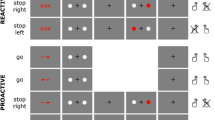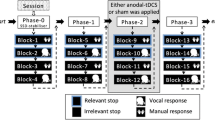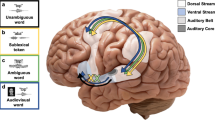Abstract
The current study examined event-related fields (ERFs) evoked by vocal response inhibition in a stimulus-selective stop-signal task. We compared inhibition-related ERFs across a younger and an older group of adults. Behavioural results revealed that stop-signal reaction times (RTs), go-RTs, ignore-stop RTs and failed stop RTs were longer in the older, relative to the younger group by 38, 123, 149 and 116 ms, respectively. The amplitude of the ERF M2 peak (approximately 200 ms after the stop signal) evoked on successful stop trials was larger compared to that evoked on both failed stop and ignore-stop trials. The M4 peak (approximately 450 ms after stop signal) was of larger amplitude in both successful and failed stops compared to ignore-stop trials. In the older group, the M2, M3 and M4 peaks were smaller in amplitude and peaked later in time (by 24, 50 and 76 ms, respectively). We demonstrate that vocal response inhibition-related ERFs exhibit a similar temporal evolution to those previously described for manual response inhibition: an early peak at 200 ms (i.e. M2) that differentiates successful from failed stopping, and a later peak (i.e. M4) that is consistent with a neural marker of response checking and error processing. Across groups, our data support a more general decline of stimulus processing speed with age.



Similar content being viewed by others
Notes
The task used by Mullis et al. (1985) consisted of three trial types that each presented a letter sequence: a low probability target (16.7 %), a high probability non-target (67 %) and an unexpected category (16.9 %). Participants had to press a button at the appearance of the low probability target. The task used by Podlesny et al. (1984) was a so-called “respond-withhold” task, which contained two conditions. One condition was very similar to the go/no-go task and another condition was similar to a selective SST.
References
Aron AR (2011) From reactive to proactive and selective control: developing a richer model for stopping inappropriate responses. Biol Psychiatry 69(12):e55–e68. doi:10.1016/j.biopsych.2010.07.024
Bedard A-C, Nichols S, Barbosa JA, Schachar R, Logan GD, Tannock R (2002) The development of selective inhibitory control across the life span. Dev Neuropsychol 21(1):93–111. doi:10.1207/S15326942DN2101_5
Bissett PG, Logan GD (2014) Selective stopping? Maybe not. J Exp Psychol Gen 143(1):455–472. doi:10.1037/a0032122
Boehler CN, Munte TF, Krebs RM, Heinze HJ, Schoenfeld MA, Hopf JM (2009) Sensory MEG responses predict successful and failed inhibition in a stop-signal task. Cereb Cortex 19(1):134–145. doi:10.1093/cercor/bhn063
Boucher L, Stuphorn V, Logan G, Schall J, Palmeri T (2007) Stopping eye and hand movements: are the processes independent? Percept Psychophys 69(5):785–801. doi:10.3758/BF03193779
Boulinguez P, Ballanger B, Granjon L, Benraiss A (2009) The paradoxical effect of warning on reaction time: demonstrating proactive response inhibition with event-related potentials. Clin Neurophysiol 120(4):730–737. doi:10.1016/j.clinph.2009.02.167
Brown WS, Marsh JT, LaRue A (1983) Exponential electrophysiological aging: P3 latency. Electroencephalogr Clin Neurophysiol 55(3):277–285. doi:10.1016/0013-4694(83)90205-5
Cai W, Oldenkamp CL, Aron AR (2012) Stopping speech suppresses the task-irrelevant hand. Brain Lang 120(3):412–415. doi:10.1016/j.bandl.2011.11.006
Castro-Meneses LJ, Johnson BW, Sowman PF (2015a) The effects of impulsivity and proactive inhibition on reactive inhibition and the go process: insights from vocal and manual stop signal tasks. Front Hum Neurosci. doi:10.3389/fnhum.2015.00529
Castro-Meneses LJ, Johnson BW, Sowman PF (2015b) Vocal response inhibition is enhanced by anodal tDCS over the right prefrontal cortex. Exp Brain Res. doi:10.1007/s00221-015-4452-0
Coxon JP, Goble DJ, Leunissen I, Van Impe A, Wenderoth N, Swinnen SP (2014) Functional brain activation associated with inhibitory control deficits in older adults. Cerebral Cortex. doi:10.1093/cercor/bhu165
Curtis CE, Cole MW, Rao VY, D’Esposito M (2005) Canceling planned action: an fMRI study of countermanding saccades. Cereb Cortex 15(9):1281–1289. doi:10.1093/cercor/bhi011
Dimoska A, Johnstone SJ (2008) Effects of varying stop-signal probability on ERPs in the stop-signal task: do they reflect variations in inhibitory processing or simply novelty effects? Biol Psychol 77(3):324–336. doi:10.1016/j.biopsycho.2007.11.005
Dimoska A, Johnstone SJ, Barry RJ, Clarke AR (2003) Inhibitory motor control in children with attention-deficit/hyperactivity disorder: event-related potentials in the stop-signal paradigm. Biol Psychiatry 54(12):1345–1354. doi:10.1016/S0006-3223(03)00703-0
Dustman RE, Emmerson RY, Ruhling RO, Shearer DE, Steinhaus LA, Johnson SC, Shigeoka JW (1990) Age and fitness effects on EEG, ERPs, visual sensitivity, and cognition. Neurobiol Aging 11(3):193–200. doi:10.1016/0197-4580(90)90545-B
Etchell AC, Sowman PF, Johnson BW (2012) “Shut up!” An electrophysiological study investigating the neural correlates of vocal inhibition. Neuropsychologia 50(1):129–138. doi:10.1016/j.neuropsychologia.2011.11.009
Falkenstein M, Hoormann J, Hohnsbein J (1999) ERP components in Go/Nogo tasks and their relation to inhibition. Acta Psychol 101(2–3):267–291. doi:10.1016/S0001-6918(99)00008-6
Falkenstein M, Hoormann J, Christ S, Hohnsbein J (2000) ERP components on reaction errors and their functional significance: a tutorial. Biol Psychol 51(2–3):87–107. doi:10.1016/S0301-0511(99)00031-9
Gläscher J, Gitelman D (2008) Contrast weights in flexible factorial design with multiple groups of subjects. http://www.jiscmail.ac.uk/cgi-bin/webadmin?A2=ind0803&L=SPM&P=R16629
Greenhouse I, Wessel JR (2013) EEG signatures associated with stopping are sensitive to preparation. Psychophysiology 50(9):900–908. doi:10.1111/psyp.12070
Hartsuiker RJ, Bastiaanse R, Postma A, Wijnen F (2005) Phonological encoding and monitoring in normal and pathological speech. Psychology Press, London
Hege MA, Preissl H, Stingl KT (2014) Magnetoencephalographic signatures of right prefrontal cortex involvement in response inhibition. Hum Brain Mapp 35(10):5236–5248. doi:10.1002/hbm.22546
Hughes LE, Rittman T, Regenthal R, Robbins TW, Rowe JB (2015) Improving response inhibition systems in frontotemporal dementia with citalopram. Brain. doi:10.1093/brain/awv133
Huster RJ, Enriquez-Geppert S, Lavallee CF, Falkenstein M, Herrmann CS (2013) Electroencephalography of response inhibition tasks: functional networks and cognitive contributions. Int J Psychophysiol 87(3):217–233. doi:10.1016/j.ijpsycho.2012.08.001
Kado H, Higuchi M, Shimogawara M, Haruta Y, Adachi Y, Kawai J, Uehara G (1999) Magnetoencephalogram systems developed at KIT. IEEE Trans Appl Supercond 9(2):4057–4062
Knösche TR (2002) Transformation of whole-head MEG recordings between different sensor positions. Biomed Eng 47(3):59–62
Kok A, Ramautar JR, De Ruiter MB, Band GPH, Ridderinkhof KR (2004) ERP components associated with successful and unsuccessful stopping in a stop-signal task. Psychophysiology 41(1):9–20. doi:10.1046/j.1469-8986.2003.00127.x
Kramer AF, Humphrey DG, Larish JF, Logan GD (1994) Aging and inhibition: beyond a unitary view of inhibitory processing in attention. Psychol Aging 9(4):491–512. doi:10.1037/0882-7974.9.4.491
Lansbergen MM, Böcker KBE, Bekker EM, Kenemans JL (2007) Neural correlates of stopping and self-reported impulsivity. Clin Neurophysiol 118(9):2089–2103. doi:10.1016/j.clinph.2007.06.011
Lavallee CF, Herrmann CS, Weerda R, Huster RJ (2014) Stimulus-response mappings shape inhibition processes: a combined EEG-fMRI study of contextual stopping. PLoS One 9(4):e96159. doi:10.1371/journal.pone.0096159
Liotti M, Pliszka SR, Higgins K, Perez Iii R, Semrud-Clikeman M (2010) Evidence for specificity of ERP abnormalities during response inhibition in ADHD children: a comparison with reading disorder children without ADHD. Brain Cogn 72(2):228–237. doi:10.1016/j.bandc.2009.09.007
Logan GD (1994) On the ability to inhibit thought and action: A users’ guide to the stop signal paradigm. In: Dagenbach D, Carr TH (eds) Inhibitory processes in attention, memory, and language. Academic Press, San Diego, pp 189–239
Logan GD, Cowan WB (1984) On the ability to inhibit thought and action: a theory of an act of control. Psychol Rev 91(3):295–327. doi:10.1037/0033-295x.91.3.295
Luck SJ (2005) An introduction to the event-related potential technique, 1st edn. MIT Press, Massachussets
Mazaheri A, Nieuwenhuis IL, van Dijk H, Jensen O (2009) Prestimulus alpha and mu activity predicts failure to inhibit motor responses. Hum Brain Mapp 30(6):1791–1800. doi:10.1002/hbm.20763
McLaren, D. (2014). Re: flexible factorial desgins (SPM mailing list archive). http://www.jiscmail.ac.uk/cgi-bin/webadmin?A2=ind1401&L=spm&P=R36001&1=spm&9=A&J=on&d=No+Match%3BMatch%3BMatches&z=4
Mullis RJ, Holcomb PJ, Diner BC, Dykman RA (1985) The effects of aging on the P3 component of the visual event-related potential. Electroencephalogr Clin Neurophysiol 62(2):141–149. doi:10.1016/0168-5597(85)90026-7
Nakata H, Inui K, Wasaka T, Akatsuka K, Kakigi R (2005) Somato-motor inhibitory processing in humans: a study with MEG and ERP. Eur J Neurosci 22(7):1784–1792. doi:10.1111/j.1460-9568.2005.04368.x
Nakata H, Sakamoto K, Otsuka A, Yumoto M, Kakigi R (2013) Cortical rhythm of No-go processing in humans: an MEG study. Clin Neurophysiol 124(2):273–282. doi:10.1016/j.clinph.2012.06.019
Nieuwenhuis S, Yeung N, van den Wildenberg W, Ridderinkhof KR (2003) Electrophysiological correlates of anterior cingulate function in a go/no-go task: effects of response conflict and trial type frequency. Cogn Affect Behav Neurosci 3(1):17–26. doi:10.3758/CABN.3.1.17
Pfefferbaum A, Ford JM, Wenegrat BG, Roth WT, Kopell BS (1984) Clinical application of the P3 component of event-related potentials. I. Normal aging. Electroencephalogr Clin Neurophysiol 59(2):85–103. doi:10.1016/0168-5597(84)90026-1
Podlesny JA, Dustman RE, Shearer DE (1984) Aging and respond-withhold tasks: effects on sustained potentials, P3 responses and late activity. Electroencephalogr Clin Neurophysiol 58(2):130–139. doi:10.1016/0013-4694(84)90026-9
Ramautar JR, Kok A, Ridderinkhof KR (2004) Effects of stop-signal probability in the stop-signal paradigm: the N2/P3 complex further validated. Brain Cogn 56(2):234–252. doi:10.1016/j.bandc.2004.07.002
Salmelin R, Schnitzler A, Schmitz F, Freund HJ (2000) Single word reading in developmental stutterers and fluent speakers. Brain 123(Pt 6):1184–1202
Schmajuk M, Liotti M, Busse L, Woldorff MG (2006) Electrophysiological activity underlying inhibitory control processes in normal adults. Neuropsychologia 44(3):384–395. doi:10.1016/j.neuropsychologia.2005.06.005
Sörös P, Cornelissen K, Laine M, Salmelin R (2003) Naming actions and objects: cortical dynamics in healthy adults and in an anomic patient with a dissociation in action/object naming. NeuroImage 19(4):1787–1801. doi:10.1016/S1053-8119(03)00217-9
Squires NK, Squires KC, Hillyard SA (1975) Two varieties of long-latency positive waves evoked by unpredictable auditory stimuli in man. Electroencephalogr Clin Neurophysiol 38(4):387–401. doi:10.1016/0013-4694(75)90263-1
Teplan M (2002) Fundamentals of EEG measurement. Measurement science review 2(2):1–11
Uehara G, Adachi Y, Kawai J, Shimogawara M, Higuchi M, Haruta Y, Hisashi K (2003) Multi-channel SQUID systems for biomagnetic measurement. IEICE Trans Electron 86(1):43–54
Uusitalo MA, Ilmoniemi RJ (1997) Signal-space projection method for separating MEG or EEG into components. Med Biol Eng Comput 35(2):135–140
van den Wildenberg WPM, Christoffels IK (2010) STOP TALKING! Inhibition of speech is affected by word frequency and dysfunctional impulsivity. Front Psychol 1:145. doi:10.3389/fpsyg.2010.00145
Verbruggen F, Chambers CD, Logan GD (2013) Fictitious inhibitory differences: how skewness and slowing distort the estimation of stopping latencies. Psychol Sci 24(3):352–362. doi:10.1177/0956797612457390
Vidal J, Mills T, Pang EW, Taylor MJ (2012) Response inhibition in adults and teenagers: spatiotemporal differences in the prefrontal cortex. Brain Cogn 79(1):49–59. doi:10.1016/j.bandc.2011.12.011
Vihla M, Laine M, Salmelin R (2006) Cortical dynamics of visual/semantic vs. phonological analysis in picture confrontation. NeuroImage 33(2):732–738. doi:10.1016/j.neuroimage.2006.06.040
Wessel JR, Aron AR (2013) Unexpected events induce motor slowing via a brain mechanism for action-stopping with global suppressive effects. J Neurosci 33(47):18481–18491
Wessel JR, Aron AR (2014) It’s not too late: the onset of the frontocentral P3 indexes successful response inhibition in the stop-signal paradigm. Psychophysiology 52(4):472–480. doi:10.1111/psyp.12374
Williams BR, Ponesse JS, Schachar RJ, Logan GD, Tannock R (1999) Development of inhibitory control across the life span. Dev Psychol 35(1):205–213. doi:10.1037/0012-1649.35.1.205
Xue G, Aron AR, Poldrack RA (2008) Common neural substrates for inhibition of spoken and manual responses. Cereb Cortex 18(8):1923–1932. doi:10.1093/cercor/bhm220
Acknowledgments
This research was supported by Macquarie University Research Excellence Scholarships (MQRES), National Health and Medical Research Council, Australia (#1003760), and the Australian Research Council (DE130100868).
Author information
Authors and Affiliations
Corresponding author
Ethics declarations
Conflict of interest
The authors declare that they have no conflict of interest.
Additional information
Leidy J Castro-Meneses and Paul F. Sowman have contributed equally to this work.
Electronic supplementary material
Below is the link to the electronic supplementary material.
Rights and permissions
About this article
Cite this article
Castro-Meneses, L.J., Johnson, B.W. & Sowman, P.F. Event-related fields evoked by vocal response inhibition: a comparison of younger and older adults. Exp Brain Res 234, 1525–1535 (2016). https://doi.org/10.1007/s00221-016-4555-2
Received:
Accepted:
Published:
Issue Date:
DOI: https://doi.org/10.1007/s00221-016-4555-2




